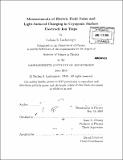Measurements of electric field noise and light-induced charging in cryogenic surface electrode ion traps
Author(s)
Lachenmyer, Nathan S. (Nathan Scott)
DownloadFull printable version (8.198Mb)
Alternative title
Measurements of electric field noise and light-induced charging in Al and Cu surface electrode ion traps at cryogenic temperatures
Other Contributors
Massachusetts Institute of Technology. Dept. of Physics.
Advisor
Isaac L. Chuang.
Terms of use
Metadata
Show full item recordAbstract
Ion traps provide an excellent tool for controlling and observing the state of a single trapped ion. For this reason, ion traps have been proposed as a possible system for large-scale quantum computation. However, many obstacles must be overcome before quantum computing can become a reality. In particular, perturbations in the electric field due to noise and electrode charging must be reduced to increase coherence of the motional quantum state. Gold has been a popular choice in the past due to its inert properties; however, it is undesirable due its incompatibility with CMOS technology. This has led to increased research into alternative CMOS-compatible materials, such as aluminum and copper. This thesis presents measurements of electric field noise and light-induced charging in aluminum, copper, and gold surface electrode traps. In addition, the effect of oxide growth on field noise and electrode charging is explored by controlling the thickness of aluminum oxide on several aluminum traps. The measurements show that electric field noise can be suppressed in aluminum traps to approximately 10-18 V2 cm-2 Hz-1, matching the noise exhibited in gold traps, and that copper traps exhibit noise within an order of magnitude of that in aluminum and gold. However, the natural oxide of aluminum poses many problems towards high-performance aluminum ion traps. The electric field noise is shown to be strongly dependent on the oxide thickness, increasing the noise by a factor of about 10 until saturation at a thickness of 13 nm. Charging of surface electrodes is shown to be highly dependent upon the material, but the model presented does not match the experimental data and is found to be incomplete. These results indicate that ion traps made out of CMOS-compatible materials can perform as well as more traditional traps fabricated from gold with respect to heating and charging as long as methods are developed for controlling oxide growth.
Description
Thesis (S.B.)--Massachusetts Institute of Technology, Dept. of Physics, 2010. Cataloged from PDF version of thesis. Includes bibliographical references (p. 85-89).
Date issued
2010Department
Massachusetts Institute of Technology. Department of PhysicsPublisher
Massachusetts Institute of Technology
Keywords
Physics.